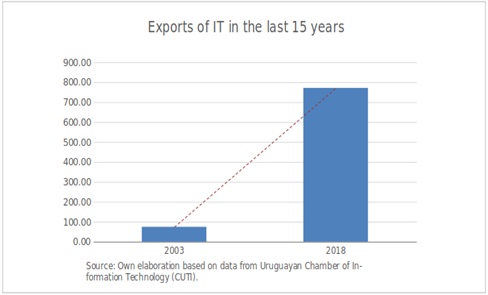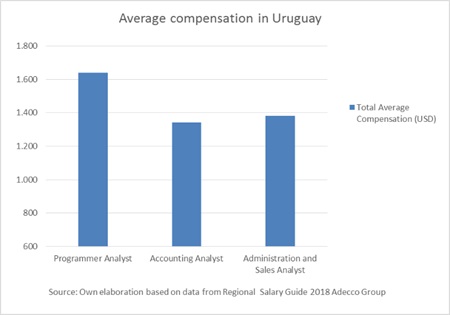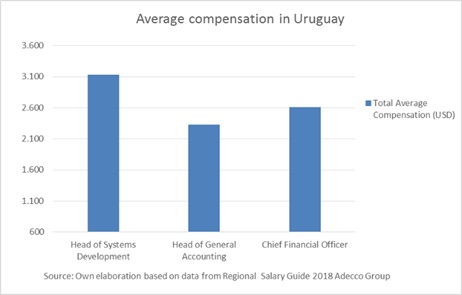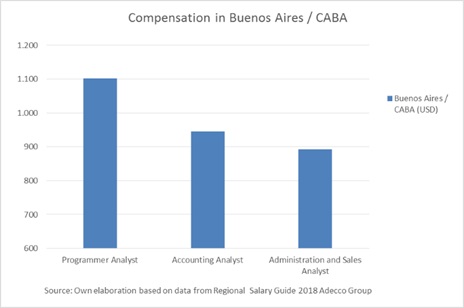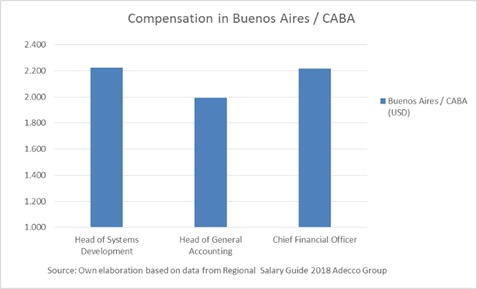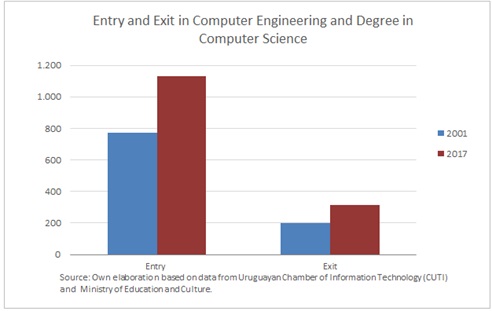Highlights of the Information
Technology Industry in Uruguay
Aspectos Destacados de la Industria de Tecnologías de la Información en
Uruguay
Rafael Sotelo [1],
Mariana Rizzi [2]
Recibido: Junio 2020 Aceptado:
Octubre 2021
Summary.- Uruguay has outstanding
achievements in Information Technology (IT) Industry. For example, it is the
country in Latin America with the highest USD export rate of IT per capita and
integrates Digital 9, the international forum of the nine governments who lead
in pioneering digital practices to improve citizens' lives. This short article
analyzes aspects of the history, infrastructure data and key indicators of the
IT industry in Uruguay. It also addresses the challenges that the IT ecosystem
faces for the future.
Keywords: IT Ecosystem; IT
indicators; IT in Latin America; e-government; industry status; industry
challenges.
Resumen.- Uruguay tiene logros sobresalientes en la Industria de
Tecnología de la Información (TI). Por ejemplo, es el país de América Latina
con la mayor tasa de exportación de TI per cápita en USD e integra Digital 9,
el foro internacional de los nueve gobiernos que lideran en prácticas digitales
pioneras para mejorar la vida de los ciudadanos. Este breve artículo analiza
aspectos de la historia, datos de infraestructura e indicadores clave de la
industria de TI en Uruguay. También aborda los desafíos que enfrenta el
ecosistema de TI para el futuro.
Palabras clave: Ecosistema de TI; Indicadores de TI;
TI en América Latina; gobierno electrónico; estado de la industria; desafíos de
la industria.
1. Introduction. - Uruguay has traditionally been recognized as an exporter of goods mainly
associated with agricultural and commodity production. However, in recent years
the growth of the IT industry has been internationally highlighted. In 2017 and
2018 exports of informatics and telecommunications exceeded those of milk and
rice. To accompany such development, several investments have been made in the
sector and there are currently multiple offers to train in IT. Nevertheless,
the sector still has a lot of potential to develop. To address this matter,
business chambers together with government agencies have been working for
several years to reinforce human resources in the sector and publicize the benefits
and potential of the industry.
The objective of this short
article is to analyze aspects of the history, infrastructure data and key
indicators of the IT industry in Uruguay. The next section describes the status
of Uruguay in the regional context. Section II describes aspects of the
county´s infrastructure. Section III presents the IT industry in numbers.
Section IV outlines the impact in education and academia and section V
concludes.
2. Status in regional context. - Uruguay
population is 3.3 million people. It stands out for having a democracy and
stable policies, as well as having an investment grade. These characteristics
make it a reliable destination for companies that wish to conduct business in
the country. Traditionally it has been an exporter of commodities produced from
agriculture like beef, wool, derivatives
of milk, soy and rice.
Nowadays, the country is internationally recognized regarding
information technologies. The early introduction of Computer Science education
decades ago, the quality of its human resources, the regulatory framework that
favors the export of software services and the support of government agencies
have been key factors for the development of the industry.
Uruguay is member of D9 (Digital 9) since 2018. D9 is a collaborative
network of the world's leading digital governments that pursue the use of digital technology to improve citizens’ lives. During
2019 Uruguay chairs the group, which is also composed of Estonia, Israel, New
Zealand, the Republic of Korea, the United Kingdom, Canada, Mexico and Portugal
[1].
Recently, Uruguay has been highlighted as the leading per capita
exporter of software in Latin America, reaching USD 120 per capita[3]. By way of comparison, Uruguay neighbors Brazil[4] and Argentina[5] export USD 12 and USD 47 per person respectively.
In Latin America region, it also stands out as one of the countries with
the highest average downloading and uploading speed, occupying the first
position in mobile broadband download speed and exceeding the global average
[6]. Table I and Table II show the figures of download and upload speed in
Latin American countries in August 2018 based on information from Speedtest Global Index.
|
Fixed broadband, August 2018 |
|
|
|
|
Global Average Download: 66,52 Mbps |
|
||
|
Global Average Upload: 35,09 Mbps |
|
||
|
Country: |
Mbps Download |
Mbps Upload |
|
|
Chile |
85,05 |
19,17 |
|
|
Panama |
76,09 |
13,50 |
|
|
Paraguay |
58,83 |
9,51 |
|
|
Uruguay |
45,62 |
11,43 |
|
|
Brazil |
42,47 |
21,23 |
|
|
Dominican Republic |
34,58 |
9,28 |
|
|
Mexico |
31,86 |
12,43 |
|
|
Argentina |
31,15 |
6,95 |
|
|
Peru |
28,65 |
5,28 |
|
|
Costa Rica |
23,91 |
6,08 |
|
|
Colombia |
23,28 |
12,58 |
|
|
Ecuador |
18,62 |
16,33 |
|
|
Bolivia |
12,48 |
5,82 |
|
|
El Salvador |
11,89 |
4,87 |
|
|
Guatemala |
11,75 |
5,80 |
|
|
Nicaragua |
8,02 |
7,89 |
|
|
Venezuela |
3,53 |
1,35 |
|
|
Source: Own elaboration based on data from Speedtest
Global Index, https://www.speedtest.net/global-index |
|||
Table I. Fixed broadband download and upload of speeds in Latin American
countries. Source own elaboration based
on data from Speedtest Global Index.
|
Mobile,
August 2018 |
|
|
|
|
Global Average Download: 28,02 Mbps |
|
||
|
Global Average Upload: 10,87 Mbps |
|
||
|
Country: |
Mbps Download |
Mbps Upload |
|
|
Uruguay |
29,02 |
13,71 |
|
|
Mexico |
25,79 |
12,42 |
|
|
Peru |
23,47 |
14,00 |
|
|
Dominican Republic |
23,07 |
9,80 |
|
|
Brazil |
23,02 |
9,66 |
|
|
Nicaragua |
22,75 |
11,94 |
|
|
Argentina |
21,89 |
10,16 |
|
|
Ecuador |
20,33 |
11,00 |
|
|
Chile |
20,08 |
13,11 |
|
|
Costa Rica |
18,83 |
8,21 |
|
|
Colombia |
18,05 |
11,09 |
|
|
Guatemala |
16,67 |
13,01 |
|
|
Bolivia |
16,12 |
11,30 |
|
|
Paraguay |
14,74 |
9,59 |
|
|
Panama |
12,30 |
10,36 |
|
|
El Salvador |
10,30 |
5,70 |
|
|
Venezuela |
7,07 |
4,34 |
|
|
Source: Own elaboration based on data from Speedtest
Global Index, https://www.speedtest.net/global-index |
|||
Table II. Mobile download and upload of speeds in Latin American
countries. Source own elaboration based
on data from Speedtest Global Index,
https://www.speedtest.net/global-index
Some figures of the latest report from the ITU [7] are represented in
Table III. The country has the highest percentage of homes with computers in
the region. It also has a percentage of the population connected to 3G and to
LTE above the average of the Americas and the World.
|
|
2017 |
||
|
|
Uruguay |
The Americas
|
World |
|
3G Coverage (% of population) |
95,0 |
93,9 |
87,9 |
|
LTE/WiMAX coverage
(% of population) |
88,0 |
84,3 |
76,3 |
|
Individuals using
the Internet (%) |
68,3 |
67,5 |
48,6 |
|
Households with
a computer (%) |
70,9 |
64,8 |
47,1 |
|
Households with
internet access (%) |
64,0 |
68,3 |
54,7 |
|
Source: Measuring the Information Society Report 2018, volume 1 &
2 - International Telecommunication Union |
|||
|
|
|||
Table III. Telecommunication coverage comparison of Uruguay, the
Americas and the World. Source
Measuring the Information Society Report 2018, volume 1 & 2 – International
Telecommunication Union (ITU)
Table IV and V show that Uruguay has a relatively cheap connectivity
price compared to the rest of the world. These elements are explained by the
universalization of broadband in the country through the implementation of
optical fiber, which in turn offers greater speed.
|
Mobile broadband prices, prepaid handset-based (500 MB), 2017 |
|
|
Country: |
as % of GNI pc |
|
Uruguay |
0,27 |
|
United States |
0,45 |
|
Canada |
0,49 |
|
Argentina |
0,71 |
|
Costa Rica |
0,84 |
|
Brazil |
1,40 |
|
Source: Measuring the Information Society Report 2018, volume 1 &
2 - International Telecommunication Union |
|
|
|
|
Table IV. Mobile broadband prices in the Americas’ countries, prepaid
handset-based. Source Measuring the
Information Society Report 2018, volume 1 & 2 – ITU
|
Mobile broadband prices, postpaid computer-based (1 GB), 2017 |
|
|
Country: |
as % of GNI pc |
|
Costa Rica |
0,48 |
|
Uruguay |
0,60 |
|
United States |
0,67 |
|
Argentina |
0,83 |
|
Canada |
1,10 |
|
Brazil |
4,82 |
|
Source: Measuring the Information Society Report 2018, volume 1 &
2 - International Telecommunication Union |
|
|
|
|
Table V. Mobile broadband prices in the Americas’ countries, postpaid
computer-based. Source Measuring the
Information Society Report 2018, volume 1 & 2 – International
Telecommunication Union
3.
Infrastructure milestones. - In Uruguay, the main telecommunications operator
is ANTEL (state-owned company). ANTEL has the monopoly over fixed lines for
both voice and Internet, which are mainly delivered through Fiber to the Home
(FTTH). Mobile services, either voice or broadband data are provided by ANTEL,
and the two private and transnational operators Telefónica and Claro; their
market share is 53%, 31% and 16% respectively.
In 1988, the first public packet
switching network was developed with national technology. During the 1990s,
ANTEL began operating cellular telephony and in 1995 the Internet access
service for companies and homes via modem was inaugurated via the copper
telephone line. In 1997 Uruguay became the first country in the Americas and
the sixth in the world to have its entire digitalized telephone network. In
2000, ANTEL began offering Internet access through ADSL broadband services. In
2004, GSM mobile and EDGE services are added for wireless data transmission. In
2005, the Agency for Electronic Government and the Information and Knowledge
Society (AGESIC) was created, whose purpose is to promote the information and
knowledge society through the good use of Information and Communications
Technologies (ICT). In 2010 begins the deployment of the Fiber optic To The Home (FTTH) national project, and in October 2011 the
first home is connected. Since 2011 ANTEL has a national and international
audiovisual signal distribution platform through FTTH and LTE. The transmission
in 4K HDR of the World Cup Russia 2018 through this network stands out as a
world class achievement [8, 9].
In 2014 the connectivity is
improved through the connection to the Monet submarine cable that allows the
direct connection of Uruguay with the United States [8, 9]. More recently,
Uruguay has been distinguished as the first country in Latin America and the
third in the world to offer 5G technology [10].
Uruguay was the first country in
the world to deploy a One Laptop per Child (OLPC) plan nationwide since 2007.
This initiative is called the Plan Ceibal. The ITU
highlights that the implementation of the Plan Ceibal
generated an increase in the number of households that have a computer [7].
However, because the percentage of households with an Internet connection
remained low, some steps were implemented such as: ANTEL begins the
"Universal Homes" project, allowing free access to the Internet and
laying of optical fiber for 300 thousand homes and for all Primary and
secondary schools in locations with more than 10,000 inhabitants. In 2017, the
public Wi-Fi network associated with the Plan Ceibal
was reformulated so that no child had to move more than 300 meters to connect
to the internet. As a result of these policies, the Internet connection gap
between lower-income and higher-income households was significantly reduced.
As of 2015, a similar plan is
implemented, the Plan Ibirapitá, which distributes
one Tablet per senior. Its goal is to promote digital inclusion in the elderly.
The National Agency for Research
and Innovation (ANII) is a government entity that promotes research and
application of new knowledge to the productive and social reality of the
country. It has been a key player by making available funds for research
projects, postgraduate scholarships and incentive programs for
entrepreneurship. [11]
4. Figures of IT industry. - The ICT industry in Uruguay is characterized by great dynamism and
growth, and the country has a focus on technology. The latter is reflected in
infrastructure investments through state-owned ANTEL, in high-quality
university education, and in the export tax benefits of these services. In
relation to the latter, the legal scenario guarantees the exemption in the
payment of Value Added Tax (VAT) for exports of software and computer services,
and the exemption to the payment of Income Tax to the production of software
when certain requirements are met [12].
According to data from the Uruguayan Chamber of Information Technology
(CUTI), the IT sector increased its turnover by 6% in 2018 reaching USD 1,687
million, in relation to the same period of 2017, this being the highest figure
in history. On the other hand, sales to the rest of the world grew by 12.7%.
Sales to the domestic market, where the state-owned company ANTEL has an
important weight, increased 1.3% in the same period. In this sense, it is
evident that companies turn to the external market since they can obtain better
prices for the services provided [13, 29]. In 2016, the turnover of the sector
represented 2.2% of the Gross Domestic Product (GDP) [14], while in 2017 this
ratio amounted to 2.5%[6] [15]. By comparison, the beef manufacturing industry accounted for 1.7%
of GDP and 1.5% respectively[7]. This is outstanding, since agricultural product, and particularly
beef, have traditionally been the main products of Uruguay.
When evaluating the evolution of the sector in relation to the
traditional export items of Uruguay, we can verify its growth and note that, in
2017 and 2018, it exceeded milk exports and those of rice [2, 16]. The main
figures of exports of Uruguay during the last years are depicted in Table VI.
|
|
Exports
of Good & Services in million of USD |
|||
|
|
2015 |
2016 |
2017 |
2018 |
|
Beef |
1.419 |
1.432 |
1.505 |
1.627 |
|
Raw wood |
572 |
591 |
706 |
746 |
|
Soy |
1.122 |
873 |
1.188 |
526 |
|
Milk |
374 |
375 |
384 |
470 |
|
Rice |
360 |
432 |
446 |
398 |
|
Informatic and Telecommunications |
310 |
364 |
465 |
517 |
|
Source: Own elaboration based on data from Uruguay XXI and Central
Bank of Uruguay. |
|
|||
Table VI. Export figures of Uruguay by category, 2015 to 2018. Source own elaboration based on data from
Uruguay XXI and Central Bank of Uruguay
As for the destination, 65.9% of exports are to the United States, and
since 2014 sales to this country have been growing significantly. Although this
data is auspicious given that the North American market is very wide, the
concentration leaves Uruguay vulnerable to regulatory changes in that country.
The second most important destination is the neighbor country Argentina, with a
5.1% share [13].
Figure I resume the dramatic growth of exports belonging to IT sector in
the period 2003-2018.
|
On the other hand, in relation to employment, the sector hires
approximately 25,000 people. One of the main obstacles that companies face is
that the number of human resources would not be keeping pace with the growth
rate of the sector. Because of this, several companies are stopping engaging
with some projects because they do not have the professionals to carry them
out. On the other hand, this fact has fostered collaboration between different
companies that have associated between them to carry out large-scale
international projects.
The lack of enough qualified specialists explains that the salary levels
are 30% above average in the country. Employers offer benefits to capture and
retain talents [13]. Figures II to V present some data from a report by the
consultant company Adecco for 2018 [17]. According to it, in Uruguay and Buenos
Aires - CABA (the capital city of Argentina, the Uruguayan closest neighbor),
the Programming Analysts would be earning, on average, approximately 20% more
than the Accounting Analysts and Administration and Sales Analysts. Meanwhile,
in Uruguay, within the leadership positions, those associated with technology
and telecommunications such as a Systems Development Department have a
remuneration 19% higher than headquarters associated with administration and
finance. However, in Buenos Aires - CABA the latter would not be the case,
given that a Chief Financial Officer would have a remuneration very similar to
a Chief of Systems Development. Besides, positions in the IT sector, either
analyst or head of department are better paid in Uruguay than in Argentina.
|
|
|
|
5. Academia and
Education.-. The beginning of university
careers associated with computer science was very early, compared to other
Latin American countries. In the ‘60s the School of Engineering of Universidad
de la República
began its courses in information technology careers [18]. Today, Uruguay
has one public and four private universities, and two public technological
universities. Research is made at these universities by researchers that are
included in a national registry managed by ANII (National System of
Researchers, SNI). Academics in the field of IT have frequent collaboration at
national and international level. ANII provides competitive funds for research
projects as well as co-founds projects in which academia collaborates with
industry fostering innovation.
There are several offers to train in information technologies, and there
is an increase in the entrance to technical and degree careers [19, 20, 21]. In
2017, incomers to IT courses increased by 4.4% in relation to 2016, at
universities and 9.9% in technical careers. Women preferred degree careers,
while men further increased the entrance into technical careers. As for the
exits, a decrease of 2.1% was observed in the degree courses, while in the
technical courses there was an increase of 27.9%, both with respect to the
previous year. Table VII and VIII show the number of students in 2017 and 2016;
it can be noted that number of women is inferior to that of men.
|
2017 |
|||||||||
|
|
Entry |
Enrolled |
Exit |
||||||
|
|
W |
M |
T |
W |
M |
T |
W |
M |
T |
|
Degree Courses |
303 |
1.261 |
1.564 |
1.010 |
3.105 |
4.115 |
97 |
378 |
475 |
|
Technical Careers |
183 |
746 |
929 |
514 |
2.134 |
2.648 |
78 |
280 |
358 |
Table VII. Number of students enrolling and graduating in IT careers and
total population in 2017, separated by women (W), men (M) and total (T). Source
own elaboration based on data from Statistical yearbook 2017 – Ministry of
Education and Culture
|
2016 |
|||||||||
|
|
Entry |
Enrolled |
Exit |
||||||
|
|
W |
M |
T |
W |
M |
T |
W |
M |
T |
|
Degree Courses |
298 |
1.200 |
1.498 |
966 |
3.289 |
4.255 |
118 |
367 |
485 |
|
Technical Careers |
186 |
659 |
845 |
460 |
1.991 |
2.451 |
49 |
231 |
280 |
Table VIII. Number of students enrolling and graduating in IT careers
and total population in 2016, separated by women (W), men (M) and total (T).
Source own elaboration based on data from Statistical yearbook 2016 – Ministry
of Education and Culture
An additional concern is the high desertion in Engineering careers. As
shown in Figure VI, between 2001 and 2017, the number of incoming students to
study in Computer Engineering or Computer Science increased by 360 but the
number of graduates increased only by 115 in 2017.
|
In addition to the careers offered by public and private universities,
there are the following programs:
a) Young people to Program: It started in 2017 and there are already
1,400 graduates of the first two editions. The 2019 edition opened only for
women. The duration of the program is 8 - 9 months. It is present on most of
the country [22].
b) B_IT: It is an online free training program that offers the title of
IT Analyst. It started in 2018. It has a duration of two years. In the 2019
edition 1,000 scholarships were offered [23].
c) Ánima: It started in 2016. It is a proposal
of technological baccalaureate that combines study with work experience. It
offers two orientations: Administration and Information and Communication
Technologies. Students carry out paid internships 12 hours a week in some of
the 21 companies that participate in the project. 62% of first-generation
students who have already graduated were hired by companies in the sector [24].
Another problem that exists is that most of the IT industry and the
general population is concentrated in Montevideo, the capital city. A project
that aims to encourage technology companies to settle in the rest of the
country is the so-called Jacarandá Project. The idea
is to promote work teams in other minor cities to encourage students from other
regions to train in IT so they do not need to travel to Montevideo to work
[25].
Among the main obstacles - which once saved will represent great
opportunities - are: as already mentioned, the low availability of trained
professionals that does not accompany the growth of the sector, the absence of
a financial market that favors risk capital, the high level of local and
international competition given that it is a sector that competes with foreign
companies, and the high turnover of technicians, which is associated with the
limited availability of professionals [13,15].
In recent years, the service sector has been characterized as one of the
most dynamic globally. In particular, services related to technologies are
becoming more important in relation to more traditional services such as
tourism and transport [26, 27], and Uruguay has followed this worldwide
process. In particular, the Uruguayan ICT industry is recognized
internationally and has proven to have an entrepreneurial culture although it
is still a sector that has a lot of potential to develop. In this sense,
business chambers together with government agencies have been working for
several years to reinforce the quality levels of human resources in the sector
and publicize the benefits offered by the country and the potential of the
industry internationally.
There are incentives for international companies to stablish in
Uruguayan free trade zones to provide IT services worldwide. This has led to
success cases in the field of Business Process Outsourcing (BPO), Knowledge
Process Outsourcing (KPO) and Information Technology Outsourcing (ITO).
Governmental Agency Uruguay XXI encourages foreign investment in the area and
facilitates responses to inquiries about potential investments [28].
In Uruguay, access to risk capitals is not usual, this has meant a
limitation for some entrepreneurs.
6. Conclusion. - In this short article, we have reviewed the current state of the IT
industry in Uruguay, the salient features of its numbers and the infrastructure
that makes it possible.
The main elements to highlight are:
- There have been several investments in infrastructure to promote the
sector and helped its development. Governmental agencies encourage investments
in the area and provide information to foreign companies considering locating
in Uruguay.
- There is a growth in the number of professionals in the area, which is
explained by the improvement of the ratio of exit – entry to technology
careers, the increase in enrollment and the “import” of human resources from
abroad. Also worth noting is the
increase of entry of woman to technology careers. All these elements help to
fill the gap that exists between the demand and the labor supply of the sector,
although it is not yet sufficient.
- Services related to technologies are becoming more important in
relation to the more traditional ones. In the last few years, the service
sector has been one of the most dynamic globally and Uruguay was not the
exception. We have seen that in recent years the sector's exports have been
growing at significant rates and have even surpassed other products already
consolidated in the Uruguayan export market.
7. References
[1] Leading Digital Governments. Available: https://leadingdigitalgovs.org Last accessed October 11, 2019
[2] Central Bank of Uruguay. Available: https://www.bcu.gub.uy/Estadisticas-e-Indicadores/Paginas/Balanza-MBP-6.aspx (In Spanish) Last accessed October 11, 2019
[3] National Statistics Institute, Uruguay. Available: http://www.ine.gub.uy/web/guest/estimaciones-y-proyecciones
(In Spanish) Last accessed October 11, 2019
[4] Central Bank of Brazil.
Available:
https://www3.bcb.gov.br/sgspub/localizarseries/localizarSeries.do?method=prepararTelaLocalizarSeries (In Portuguese) Last accessed October 11, 2019
[5] National Institute of Statistics and Censuses, Argentina. Available:
https://www.indec.gob.ar/indec/web/Nivel4-Tema-3-35-45
(In Spanish) Last accessed October 11, 2019
[6] Economic Commission for Latin America and the Caribbean, August
2016. The new digital revolution: from the Internet of consumption to the
Internet of production. Available: https://www.cepal.org/en/publications/38767-new-digital-revolution-consumer-internet-industrial-internet Last accessed October 11, 2019
[7] International Telecommunication Union (ITU), 2018. Measuring the
Information Society Report, volume 1 and volume 2. Available: https://www.itu.int/en/ITU-D/Statistics/Pages/publications/misr2018.aspx Last accessed October 11, 2019
[8] National Telecommunications Administration (ANTEL). Historic Review.
Available: http://www.antel.com.uy/institucional/nuestra-empresa/resena-historica
(In Spanish) Last accessed October 11, 2019
[9] Catholic University of Uruguay, Competitiveness Institute, School of
Business Sciences, 2015. The ICT Industry in Uruguay: Analysis of
Competitiveness and Clustering Possibilities. Available: https://ucu.edu.uy/sites/default/files/facultad/fce/i_competitividad/La_Industria_de_las_TIC_en_Uruguay%202015_InstitutodeCompetitividad_UCU.pdf (In Spanish) Last accessed October 11, 2019
[10] NOKIA website: “ANTEL and Nokia make the first 5G call on a
commercial network in Latin America”. Available: https://www.nokia.com/about-us/news/releases/2019/04/10/antel-and-nokia-make-the-first-5g-call-on-a-commercial-network-in-latin-america/ Last accessed October 11, 2019
[11] National Agency for Research
and Innovation (ANII). Available: https://www.anii.org.uy/institucional/acerca-de-anii/#/acerca-de-anii (In Spanish) Last accessed October 11, 2019
[12] DCA Professional Services, 28 February 2019. Tax modifications for
the Software activity in Uruguay. Available: https://www.dca.com.uy/wp-content/uploads/2019/02/Modificaciones-impositivas-para-la-actividad-de-Software-en-Uruguay.pdf (In Spanish) Last accessed October 11, 2019
[13] Radio Broadcasting ‘En Perspectiva’, 27
September 2018. Interview to the President of CUTI. Available: https://www.enperspectiva.net/home/ano-record-las-tecnologias-la-informacion-facturacion-del-sector-aumento-26-2017-crecimiento-extraordinario-segun-leonardo-loureiro-cuti/ (In Spanish) Last accessed October 11, 2019
[14] Uruguayan Chamber of Information Technology (CUTI). Revenue from
the ICT sector accounted for 2.2% of GDP in 2016 and exports grew 10%. Available:
https://www.cuti.org.uy/novedades/662-ingresos-del-sector-de-las-tic-represento-2-2-del-pib-en-2016-y-exportaciones-crecieron-10
(In Spanish) Last accessed October 11, 2019
[15] Radio Broadcasting ‘FM del Sol’, 17 July 2019. Interview to the
President of CUTI. Available: https://delsol.uy/facildesviarse/entrevista/de-quien-es-el-exito-de-la-industria-del-software-uruguayo (In Spanish) Last accessed October 11, 2019
[16] Uruguay XXI. Exports by items 2001-2018. Available: https://www.uruguayxxi.gub.uy/es/centro-informacion/articulo/exportaciones-por-partidas/
(In Spanish) Last accessed October 11, 2019
[17] The Adecco Group, 2018. Regional Salary Guide Argentina – Uruguay
2018.
[18] Uruguay XXI, August 2014. The ICT industry in Uruguay. https://www.smarttalent.uy/innovaportal/file/862/1/la_industria_tic_en_uruguay.pdf
(In Spanish) Last accessed October 11, 2019
[19] Ministry of Education and Culture. Statistic yearbook 2017.
https://www.mec.gub.uy/mecweb/mec2017/container.jsp?contentid=927&site=5&channel=mec&3colid=927
(In Spanish) Last accessed October 11, 2019
[20] Ministry of Education and Culture. Statistic yearbook 2016. Available:
https://www.mec.gub.uy/mecweb/mec2017/container.jsp?contentid=927&site=5&channel=mec&3colid=927
(In Spanish) Last accessed October 11, 2019
[21] Uruguayan Chamber of Information Technology (CUTI), May 2018.
Academic Training in ICT, Report 2017. Available: https://www.cuti.org.uy/public/documentoscuti/Informe%202017%20Formacion%20Academica%20en%20TIC_Cuti.pdf (In Spanish) Last accessed October 11, 2019
[22] Youth to Program. https://jovenesaprogramar.edu.uy/ (In Spanish) Last accessed October 11, 2019
[23] B_IT Program. http://bit.cuti.org.uy/
(In Spanish) Last accessed October 11, 2019
[24] Ánima. Available: https://anima.edu.uy/nuestra-propuesta/ (In Spanish) Last accessed October 11, 2019
[25] Jacarandá Proyect.
Available: https://www.presidencia.gub.uy/comunicacion/comunicacionnoticias/industria-tecnologia-cuti-loureiro-cosse-descentralizacion-interior (In Spanish) Last accessed October 11, 2019
[26] United Nations Conference on Trade and
Development (UNCTAD), 28 May 2019. International Trade in Services 2018.
Available: https://unctad.org/en/PublicationsLibrary/gdsdsimisc2019d9_en.pdf Last accessed October 11, 2019
[27] Uruguay XXI, February 2017. Global Export Services in Uruguay. Available:
https://www.uruguayxxi.gub.uy/uploads/informacion/Global-Export-Services-Uruguay-XXI-February-2017-7.pdf Last accessed October 11, 2019
[28] National Agency Uruguay XXI.
Available: https://www.uruguayxxi.gub.uy/en/invest/sectors/global-services-2/it-industry/ Last accessed October 11, 2019
[29] El Pais Newspaper. Available: https://www.elpais.com.uy/negocios/noticias/sector-tecnologia-alcanzo-facturacion-record-aspira-peso-mayor-pib.html Last accessed September 12, 2021
